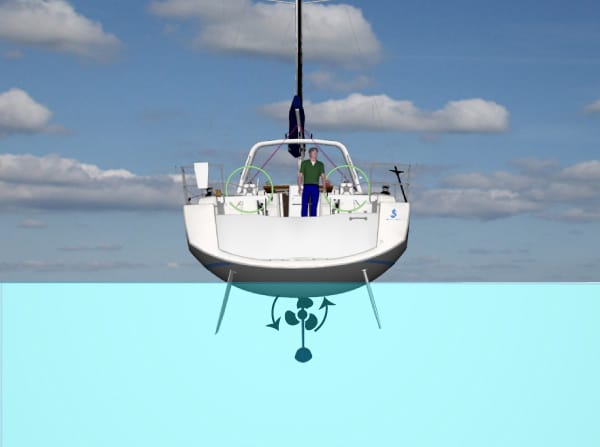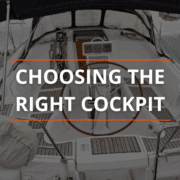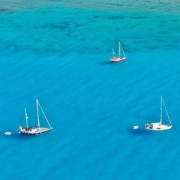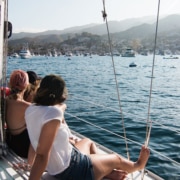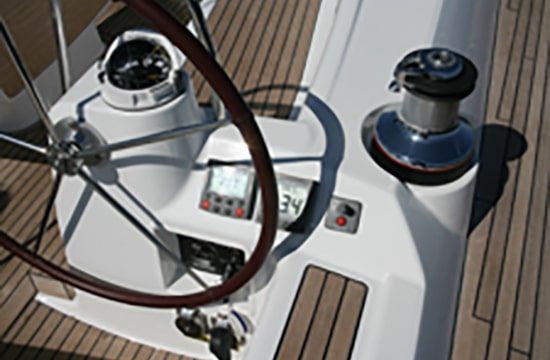
This article is an excerpt from NauticEd’s Maneuvering Under Power, a comprehensive online course that empowers you to dock and maneuver large sailboats. The Maneuvering Under Power course is part of the Skipper Large Sailboat bundle of online courses, fully preparing you to sail large sailboats over 25ft.
You can learn to sail and improve your sailing with NauticEd, the international leader in sailing education.
Dual Rudder: Maneuvering Under Power
Part of being a forward-thinking sailing education company includes constantly updating our material as a result of new developments, student feedback, and our own team’s experiences. Because, what’s one of the thousands of benefits of online sailing education? Courses can be updated without publishing an entirely new physical book. In other words, we can make sure that our information is up-to-date and serves our students well.
** Maneuvering Under Power UPDATE to include dual rudder monohulls **
Many newer boats have dual rudders, so we’ve updated our Maneuvering Under Power course to reflect this change. When a monohull sailboat has dual rudders, it will act differently than with a single rudder, so knowing what these differences are and how to manage them will save you a lot of headaches (and will keep you safer).
Ummm do I have a dual rudder monohull?
Don’t confuse dual helms with dual rudders! Dual helms do not necessarily mean dual rudders. You’ll have to either check the actual boat specs to see if it has dual rudders under the water or go for a swim and look!
Tip: This is a good thing to ask about if you’re chartering a sailboat internationally.
What’s the Advantage to a Dual Rudder?
When sailing, a dual rudder configuration offers several advantages over a single rudder. One of the main benefits is the increased rudder surface area in the water, which enhances maneuverability, control, and reduces the tendency to round up into the wind when hit by a gust. Additionally, it can improve the boat’s ability to sail upwind.
However, there is a trade-off: the boat becomes less maneuverable under power and during docking, which is when incidents are more likely to occur.
What is the main difference between maneuvering single or dual rudder monohulls?
Propeller wash over the rudder is a key consideration. In the case of single rudder monohulls, the rudder is positioned directly behind the propeller. As a result, when the boat’s engine is in forward gear, the wash from the propeller flows directly onto the rudder. This enables you to manipulate the boat’s stern in any desired direction without relying on the boat’s speed through the water—just by using the thrust of the prop wash.
With dual rudders, the propeller wash does not flow over the rudder, thus eliminating this maneuvering capability.
The absence of propeller wash makes it challenging to effectively utilize spring lines during docking because you cannot utilize the opposing force vectors between the rudder force generated by the prop wash and the dockline pulling the boat towards the dock.
Bow Thrusters with a Dual Rudder Sailboat
Most dual rudder boats have a bow thruster. This is essentially an electric motor that is mounted sideways under the water line at the bow of the boat. The bow thruster pushes water to one side or the other depending on how you need the bow to move. This makes maneuvering your boat a whole lot easier and gives you a lot more control.
BUT – as with anything on a boat, bow thrusters break. Do you have the inherent skills for maneuvering your dual rudder boat without the use of a bow thruster?
For more details (and our trademark animations to really make sure you understand), sign up for our Maneuvering Under Power course.
Become an Expert at Maneuvering
When it comes to maneuvering under power in a marina, no one wants the embarrassment of looking like an amateur. This is a comprehensive maneuvering course full of animations and tips and tricks. It is hands down the best maneuvering course in the world.
If you already have the Maneuvering Under Power course in your NauticEd curriculum, you can sign back in and gain access to this upgrade for FREE.
If you have not taken this valuable course, the $39 investment is guaranteed to save you money as well as prevent embarrassment.
Maneuvering a Catamaran
Are you still in the mood for learning about maneuvering boats in a marina/under power? Check out our recent post about maneuvering a catamaran in a marina or to a mooring ball. Obviously, catamarans are different than monohulls, so if you’re planning on sailing a catamaran (or if you’re just curious), check out the post at the link below.
Virtual Reality Sailing Courses!
One more thing. We’ve launched a virtual reality sailing course that really brings maneuvering under power to life. This is probably one of the sailing education lessons that people are the most hesitant to learn in real life, so we’ve found a way to make the gap between “book” knowledge and experience a little smaller and less intimidating.
Watch our introduction video to practicing in a marina in virtual reality.

